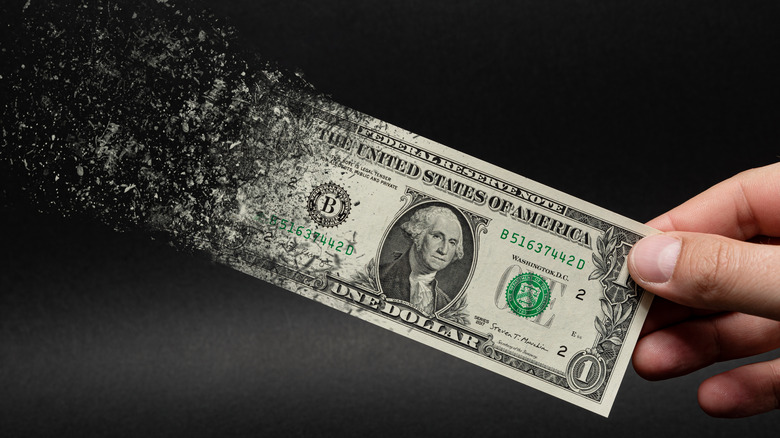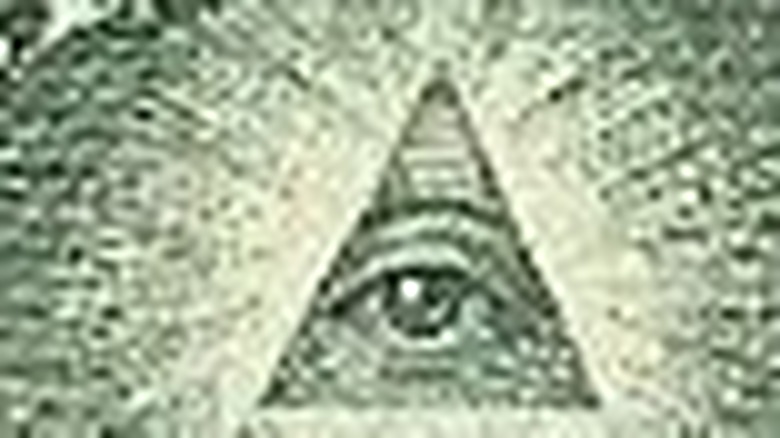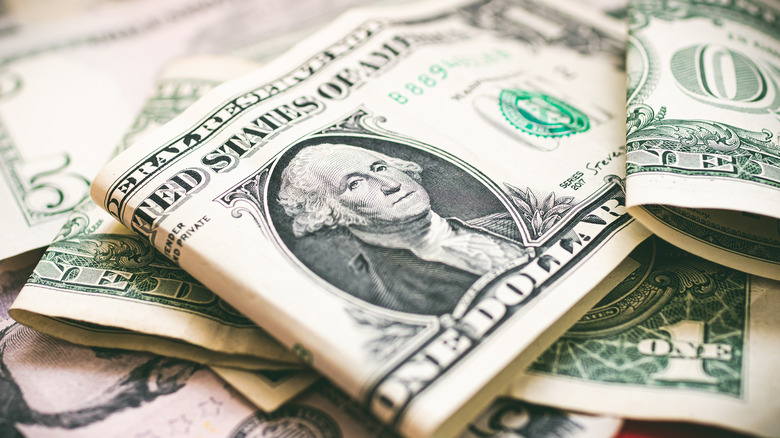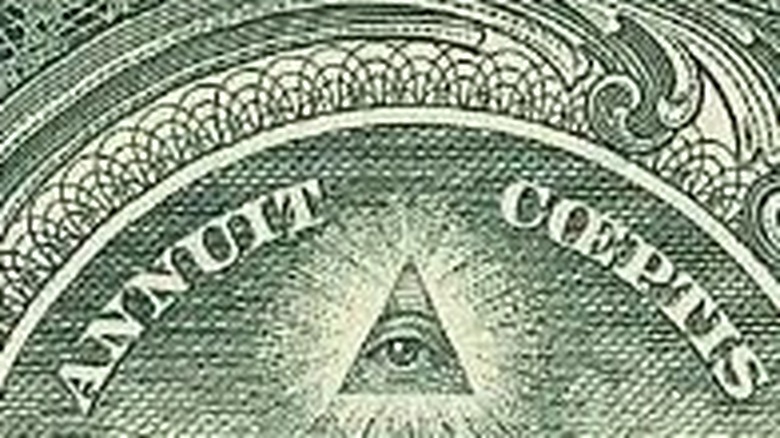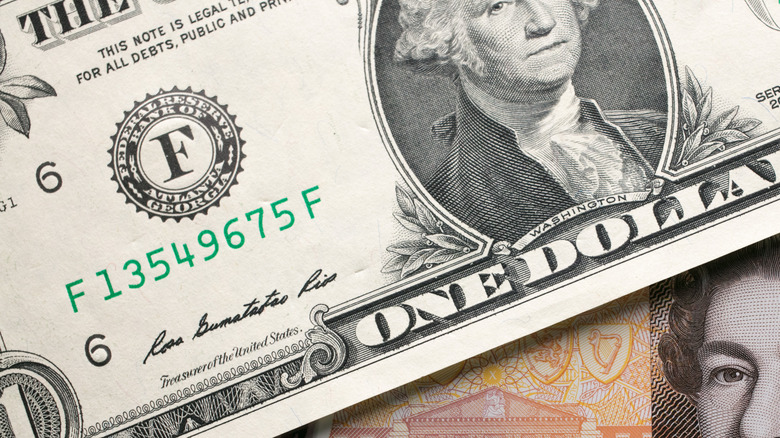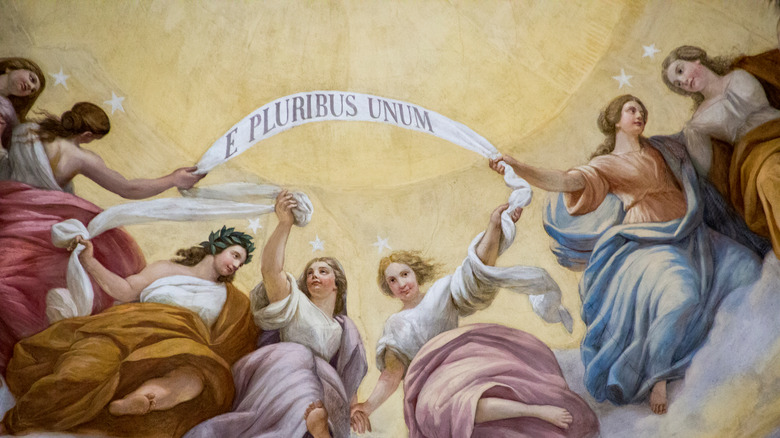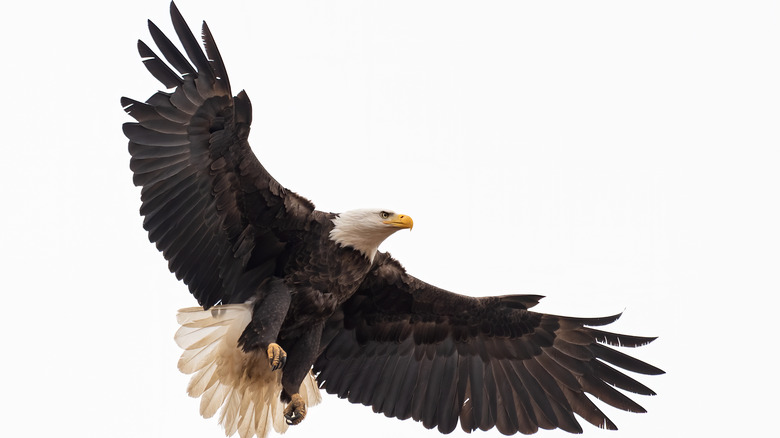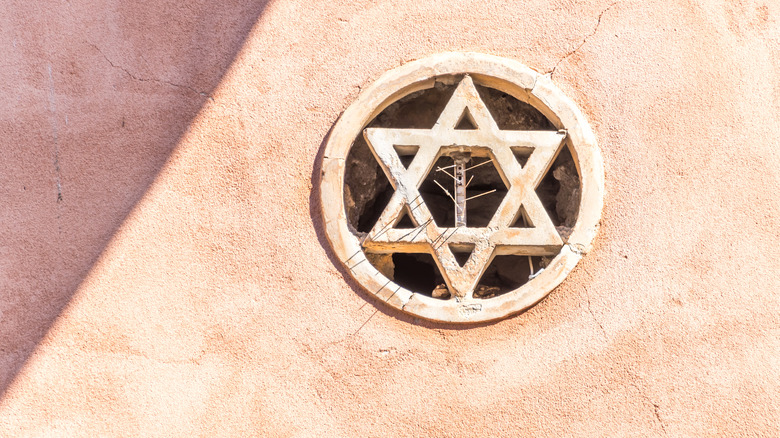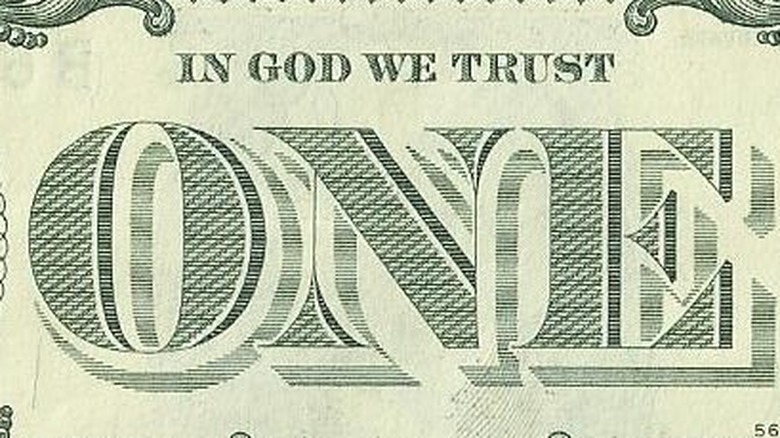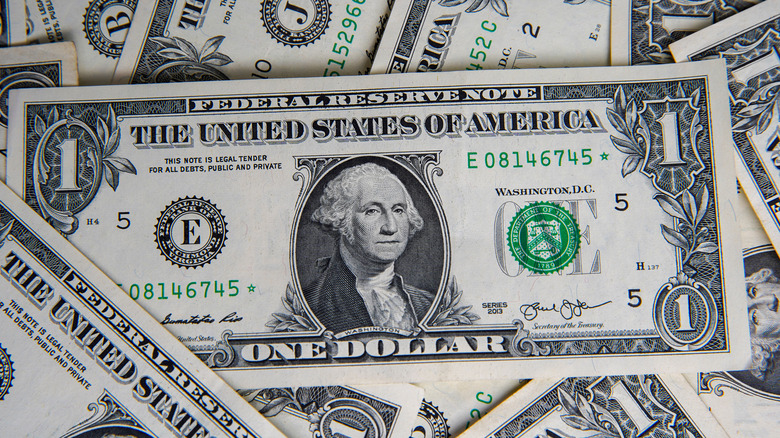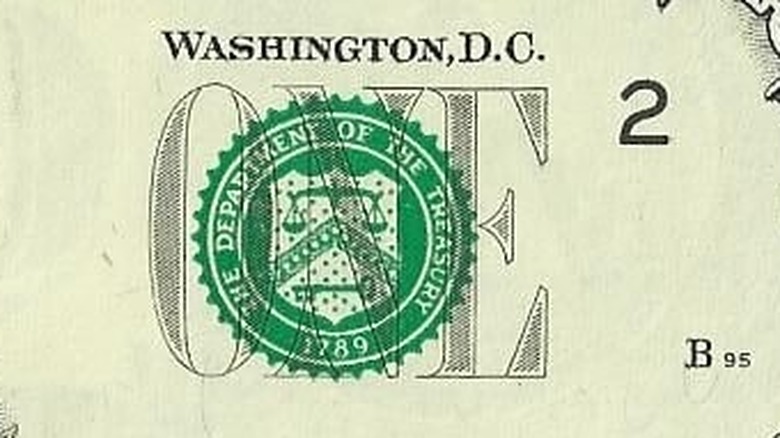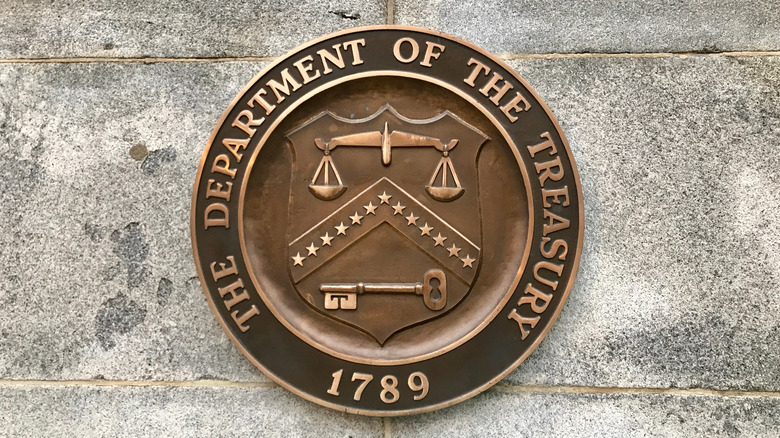Every Symbol On The Dollar Bill Explained
Few banknotes are as recognizable as United States dollars. Valued around the world for their status as world reserve currency (via Investopedia), millions of people can identify these banknotes and most merchants around the world are only too happy to accept them as payment. But most, including many Americans, are not familiar with the history of the design of the banknotes.
U.S $1 bills, which are not really dollars but Federal Reserve Notes (a dollar is legally defined as a silver coin with a particular silver percentage), are a relatively recent phenomenon, having only been introduced into circulation in 1963 (via the Treasury Department). The symbols, however, date all the way back to country's 18th century founding. Together, they explain the Enlightenment-inspired ideology of America's founders, in which a group of individuals and sovereign states came together to forge a new nation. Here are the symbols of the $1 bill explained.
Eye of Providence
The Eye of Providence, also known as the all-seeing eye, adorns the reverse of the Great Seal of the United States. The symbol is controversial because of its masonic associations and the question of the power of freemasonry in the early United States. The George Washington Masonic Memorial (GWMM) notes that the symbol was originally Christian. The design is based upon the description of God's eye in Sirach 23:19, which states that it shines "ten thousand times brighter than the sun" as it benevolently watches over the world. The triangle is representative of the Trinity. But is it masonic?
The Scottish Rite of Freemasonry denies any masonic connections with the eye. But the GWMM states that the all-seeing eye entered masonic symbology as early as the 17th century. This showcased a shift in the eye's meaning. It no longer referred to the Christian God, but to the masonic, all-powerful "benevolent creator and founder of general laws" according to political scientist Eve Darian-Smith's book "Religion, Race, Rights."
The American Declaration of Independence expresses this exact sentiment, stating that all men were "endowed by their Creator with certain unalienable Rights." Thus, it is difficult not to see masonic influence on the seal, especially since according to the National Foundation of Patriotism, the eye was the brainchild of masonic grand master Benjamin Franklin (via Grand Lodge of Ohio). It fits the idea of a creator watching over the United States, and if the Founders intentionally used "Creator" instead of "God," it is unlikely they meant the Christian God.
Unfinished pyramid
The pyramid is another symbol commonly associated with freemasonry. Like the all-seeing eye, the Scottish Rite denies any official usage of the symbol. Officially, according to the 1782 Continental Congress, the designers of the seal had their own interpretation of the unfinished pyramid. The structure represents "strength and duration."
According to the Bellevue University Economics Department, the 13 layers of the pyramid represent the 13 original colonies. Thus, the pyramid is a representation of a strong and united early republic, although in reality, this was not the case. But why the unfinished pyramid? It is not known for certain, but Bellevue suggests that it represented the United States' capacity for growth and expansion. As the nation grew, new layers of the pyramid would be added. This strong and durable nation is watched over by the Eye of Providence, the creator who endowed Americans with their inalienable rights.
Although the pyramid officially has no masonic connections, it seems unlikely Freemasonry did not influence the designers. Washingtonian Magazine notes that the partially constructed pyramid is used among masonic lodges and appears in Mozart's masonic allegory "The Magic Flute." According to Michigan State University's exhibit "Union to Disunion," at least nine of the framers of the U.S. Constitution were freemasons, including Benjamin Franklin and George Washington. Freemasonry and the Enlightenment philosophy upon which the United States was partially built went hand-in-hand, so it would be no surprise that it would appear on the currency of the world's premier experiment in Enlightenment principles.
Annuit coeptis
Above the pyramid and the all-seeing eye is the Latin phrase "Annuit Coeptis." According to the Independence Institute, it translates to "God (or the Creator) has approved/favored our undertakings." "God" is implicit as the subject of the verb "annuit." Now the Founders and other educated men of their time were all great admirers of the classical Greco-Latin tradition, which informed them in almost every aspect of their intellectual lives. Charles Thomson, who designed the Great Seal, borrowed the phrase "annuit coeptis" from Book IX, line 625 of Virgil's "Aeneid," which reads: "Omnipotent Jupiter, favor (our) bold undertakings!"
The interpretation of this statement, whose position suggests it relates to the all-seeing eye, is that God, the creator, or some sort of theistic entity had divinely ordained the creation of the United States. According to "The New American Exceptionalism," this strand of thinking could be traced to the Puritans, who saw themselves as divinely ordained to establish an ideal society in New England that would be, as Governor John Winthrop called it, "a city on a hill." According to the University of Chicago, it was the first appearance of what later eventually became Manifest Destiny, the idea that the U.S. was divinely ordained to reach "from sea to shining sea."
Novus Ordo Seclorum
Accompanying the phrase "annuit coeptis" is another Latin phrase: "Novus Ordo Seclorum," which is a contraction of "Novus Ordo Saeculorum." According to Liberty Magazine, this phrase translates in Classical Latin as "new order of/for the ages." Above the Latin phrase on the base of the pyramid, is a Roman numeral that demystifies the phrase. The numeral is MDCCLXVII, which in Arabic numerals, is 1776. Most will recognize this as the year the United States declared independence from the British Empire.
Thus, the "novus ordo seclorum," according to the Continental Congress, was the beginning of the "American Era." As Liberty Magazine notes, the American Era would differentiate the New World from the Old. The United States would be free from kings, popes, established churches, religious wars, tyrannical dictats and any ensuing mayhem. The Founders hoped that this new era in history would bring peace between competing religions and ideas in America by ensuring speech and conscience were protected from arbitrary government interference. They were, after all, unalienable rights directly from the creator.
Like most symbols on the $1 Federal Reserve Note, the phrase has been scrutinized for nefarious connotations. Educator and writer John Taylor Gatto noted in a NY Times letter to the editor that the phrase "novus ordo seclorum" can also be translated as "new world order" in the sense of a planetary, one-world government, which has been on the lips of many politicians as of late. But given the clear correlation with the 1776 date, it does not appear that there is anything occultic or secret behind this particular phrase.
E Pluribus Unum
The phrase "e pluribus unum" appears on the U.S. dollar bill in the beak of the bald eagle on the obverse of the Great Seal. This phrase is at the forefront of the culture wars regarding America's identity in the face of changing demographics and the numerical decline of people of European descent (via Pew). When Tucker Carlson lambasted multiculturalism on his Fox show, the Washington Post accused him of betraying this famous motto. After all, "e pluribus unum" literally means "out of many, one."
While America has always been a multicultural nation in the sense that different nationalities, religious denominations and ethnicities have always been present, the association of the motto with modern multiculturalism (which is philosophical idea/political ideology) distorts its original meaning. According to the Classical Journal, the phrase "e pluribus unum" has classical origins in Greco-Latin literature, most famously in Cicero and Aristotle. It is unclear how the Founders came to it, but the Classical Journal traces it to Benjamin Franklin.
The reasoning for the motto relates to the conception of a union of states. Cornell's Legal Information Institute notes that legally, the original 13 states were sovereign entities. Thus, "e pluribus unum" captured the ideal of these sovereign entities coming together to form a new nation, whose inhabitants, despite their differences, could unite under one nation in commitment to a set of higher principles. Taken further, it was a collection of individuals coming together for a higher purpose into a sort of family, as Cicero wrote in his "De Officiis." It was never, however, an endorsement on multiculturalism in the modern sense, since the Founders were hardly advocates of racial or cultural equality.
The Bald Eagle
The Bald Eagle graces the center of the Great Seal as the United States' national bird. According to History, there were two candidates for national bird: the American Bald Eagle and the White Eagle. Charles Thomson favored the former and Pennsylvania lawyer William Barton the latter. Thomson's choice won out. Benjamin Franklin did not advocate for the turkey, but he did call the Bald Eagle a "bird of bad moral character" in a 1784 letter to his daughter. The eagle carries a number of items that all epitomize the traditional American character.
The choice of the Bald Eagle was grounded in tradition. Numerous European countries and cultures have viewed the eagle as a national or imperial symbol (e.g. Albania, Russia, Byzantium, and Rome). The classically inclined Founders likely would have been aware of the Roman legions' battle standards, which were topped with an eagle. The designers of the great seal added an olive branch and arrows to the eagles right and left talons respectively. The olive branch indicated the American desire to live peacefully amongst sovereign nations. The arrows, however, were a warning that the new nation would defend itself against foreign aggressors.
The records of the Continental Congress also mention a shield emblazoned in front of the eagle. The shield is composed of 13 stripes representing the 13 original states and a blue rectangle representing congress, which holds the states together in unity. The red and white represent valor and purity respectively, while blue is the color of perseverance. The eagle supports this shield alone, reminding the American people to support themselves with their own virtue.
The 'Star of David'
Above the bald eagle is set a six-pointed star made of 13 smaller stars that resembles the Jewish Star of David. In 2015, ABC News reported that former Housing and Urban Development director Dr. Ben Carson told an apocryphal tale that ascribed the star's shape to Jewish financier Haym Solomon. This man helped fund the American Revolution to the tune of nearly $700,000, an enormous sum at the time. In gratitude, the star above the eagle was patterned after the Star of David to honor his contributions as a Jew to the American war effort. But as Florida Jewish News notes, the story of the star is probably just a myth.
According to the State Department, the star is a constellation of 13 stars forming one larger star. Each small star represents one of the 13 original states, which together form the larger star, the United States of America. The star represents a new nation taking its place in the world among the other constellations (aka sovereign states). The connection to Judaism and Haym Solomon is an attractive one, but it does not seem to have any basis in the historical record.
It is possible, however, according Jewish Yeshiva Ohr Somayach, that the founders intended to choose a shape with biblical associations, although it is not clear if they specifically had Judaism in mind when the Great Seal was adopted, since according to Monticello, there were other proposed designs that eschewed the star.
In God We Trust
"In God We Trust” is the national motto of the United States and appears above the ONE on the reverse of the $1 Federal Reserve Note. According to the Treasury Department, there was an upswing in Christian religious sentiment around the time of the American Civil War. In 1860-61, President Abraham Lincoln's Secretary of the Treasury Salmon P. Chase, who was tasked with submitting the annual report on the country's finances, received an angry letter from Pennsylvania clergyman Reverend M.R. Watkinson. According to Watkinson, the American faith in the Christian God was not adequately represented on the nation's money. America, in not honoring God on its coinage, was de facto disavowing God and his divine protection. He argued that some sort of proclamation should be placed on the currency that reinforced America's trust in God.
Secretary Chase agreed with the reverend. At the time, there was no $1 billl. According to the American Numismatics Society, currency (aka paper money) was the domain of private banks, who issued notes redeemable in gold or silver. The Federal Government was (and legally still is) constitutionally restricted to the minting of coins. So he ordered that some U.S. coinage bear the motto, although its use was inconsistent. It only became the official motto in 1956 under President Dwight Eisenhower. In 1957, it appeared on U.S. silver certificates by law and eventually the $1 Federal Reserve Note in 1964, one year after the denomination was issued.
George Washington
Gracing the obverse of the $1 Federal Reserve Note is George Washington, the first president of the United States. It makes sense that George Washington should be on the $1 bill. But he was not originally. According to the Department of the Treasury, Washington only first appeared on the treasury notes in 1869. The original note was released in 1862 and featured Abraham Lincoln's treasury secretary, Salmon P. Chase.
Before 1964, the U.S. government used to issue certificates which, unlike current federal reserve debt notes, were redeemable silver (or gold before 1933). Among these was a $1 silver certificate that, unlike the $1 treasury note, did not feature George Washington. Instead, Martha Washington, the first president's wife, graced the front of these notes. Thus, according to the Mt. Vernon website, she is the first and only woman to ever appear on any U.S. paper currency.
Numbers and seals to the right of George Washington
To the right of George Washington's portrait are a series of numbers, letters, and a seal that are of little use to the average person, but are important for tracking Federal Reserve Notes in circulation. Contrary to popular belief, the United States Government does not issue the national currency. Instead, the privately owned Federal Reserve System has issued currency since the old treasury notes were discontinued in 1971 (via the St. Louis Fed).
The letters and numbers to the left of Washington's portrait are related to the origins of the particular notes. The large seal with a letter in the middle can feature A-L, which represent the Federal Reserve bank that issued the note. According to NFOP and using the serial number, B49566515G, the meanings are quite straightforward. The letter B signifies that the New York Fed issued the note in question. The numbers are the serials, which the Atlanta Fed says are used to track the notes and identify counterfeits. The final letter is the printing run. Each serial number undergoes 26 printing runs in batches of 32 notes at the Bureau of Engraving and Printing, the Federal office that prints physical dollar notes. Thus, the letter G in the above example simply means the note was part of the seventh run of this particular serial number.
The Treasury seal
Stamped to the right of George Washington's portrait is the seal of the Department of the Treasury, which according to the same agency, was adopted in 1968. The symbolism behind the seal is straightforward. The scales represent justice, and the key represents official government authority. The single chevron emblazoned with 13 stars represents the original 13 states.
The stamp is related to the Federal Reserve Note's status as legal tender. The Treasury Department has historically stamped U.S. currency as a symbol of the government's obligation to the bearer and denoted the currency as legal tender. According to Chicago Gold Gallery, the most famous ones are the blue, yellow, and red seals. Notes with yellow or blue seals were redeemable in gold or silver respectively. The red seals, originally used in the 1860s, were U.S. government debt obligations to those who held them. In other words, whoever bore a note with a red stamp literally bore a piece of the national debt. The U.S. dollar's convertibility to gold ended for ordinary Americans in practice in 1933 and officially in 1971, along with these treasury stamps.
Today, the stamps have been replaced with a green one. According to Investopedia, Federal Reserve Notes are backed by nothing more than U.S. government diktat, which proclaims that they are legal tender. The green treasury stamp, according to the Treasury Department, affirms this. But this is not without controversy, since proponents of sound money, according to Law and Liberty, make strong arguments for the unconstitutionality of both the Federal Reserve and the notes it issues.
